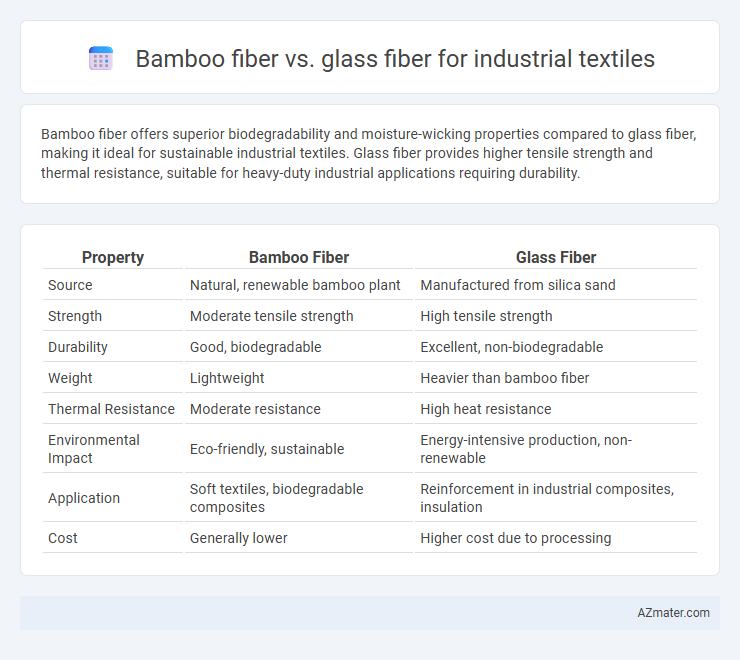Bamboo fiber offers superior biodegradability and moisture-wicking properties compared to glass fiber, making it ideal for sustainable industrial textiles. Glass fiber provides higher tensile strength and thermal resistance, suitable for heavy-duty industrial applications requiring durability.
Table of Comparison
| Property | Bamboo Fiber | Glass Fiber |
|---|---|---|
| Source | Natural, renewable bamboo plant | Manufactured from silica sand |
| Strength | Moderate tensile strength | High tensile strength |
| Durability | Good, biodegradable | Excellent, non-biodegradable |
| Weight | Lightweight | Heavier than bamboo fiber |
| Thermal Resistance | Moderate resistance | High heat resistance |
| Environmental Impact | Eco-friendly, sustainable | Energy-intensive production, non-renewable |
| Application | Soft textiles, biodegradable composites | Reinforcement in industrial composites, insulation |
| Cost | Generally lower | Higher cost due to processing |
Introduction to Bamboo Fiber and Glass Fiber
Bamboo fiber, derived from the pulp of bamboo plants, is a sustainable and biodegradable material widely used in industrial textiles for its softness, breathability, and antibacterial properties. Glass fiber, composed of fine strands of glass, offers exceptional strength, durability, and resistance to heat and chemicals, making it a preferred choice for reinforcement in composites and heavy-duty industrial applications. Both fibers play distinct roles in industrial textiles, with bamboo fiber emphasizing eco-friendly performance and glass fiber providing high structural integrity.
Material Composition and Production Processes
Bamboo fiber, derived from the cellulose-rich pulp of bamboo plants, offers a renewable, biodegradable alternative with natural antibacterial properties, while glass fiber consists of fine strands of glass, primarily composed of silica, alumina, and other oxides, providing high tensile strength and resistance to heat and chemicals. The production of bamboo fiber involves mechanical or chemical processes to extract and refine the cellulose, focusing on sustainability and low-energy consumption, whereas glass fiber manufacturing requires melting raw materials at high temperatures followed by fiber drawing and cooling, resulting in a strong but energy-intensive product. Material composition impacts their industrial textile applications, with bamboo fiber favored for eco-friendly, breathable fabrics and glass fiber preferred in reinforcement materials demanding durability and thermal resistance.
Mechanical Properties Comparison
Bamboo fiber exhibits high tensile strength and excellent flexibility, making it suitable for lightweight industrial textiles with moderate mechanical loads. Glass fiber offers superior tensile and impact strength, along with higher stiffness and resistance to abrasion, ideal for heavy-duty applications requiring durability and structural integrity. Comparing the two, glass fiber outperforms bamboo fiber in mechanical properties such as modulus of elasticity and fracture toughness, but bamboo fiber provides eco-friendly benefits and a lower density for applications prioritizing weight reduction.
Environmental Impact and Sustainability
Bamboo fiber offers significant environmental benefits over glass fiber due to its renewable nature, rapid growth rate, and biodegradability, reducing carbon emissions and waste in industrial textile production. In contrast, glass fiber involves energy-intensive manufacturing, non-renewable raw materials, and challenges in recycling, leading to higher environmental impact and limited sustainability. Choosing bamboo fiber supports sustainable practices by promoting eco-friendly sourcing, lower water usage, and reduced ecological footprint in industrial textile applications.
Durability and Longevity in Industrial Applications
Bamboo fiber offers moderate durability with natural resistance to moisture and microbial growth, making it suitable for lightweight industrial textiles requiring eco-friendly materials. Glass fiber exhibits superior strength, high tensile durability, and excellent resistance to heat, chemicals, and abrasion, ensuring long-term performance in heavy-duty industrial applications. Glass fiber's longevity surpasses bamboo fiber in demanding environments, making it the preferred choice for reinforcing composites and industrial fabrics exposed to extreme conditions.
Cost Analysis and Market Availability
Bamboo fiber offers a cost-effective alternative to glass fiber in industrial textiles due to its renewable sourcing and lower raw material expenses, while glass fiber incurs higher manufacturing costs related to energy-intensive processes. Market availability favors glass fiber with well-established global supply chains and widespread industrial adoption, whereas bamboo fiber, though rapidly growing, remains limited in large-scale commercial penetration. Bamboo's biodegradability and eco-friendly appeal drive niche market growth, but glass fiber continues to dominate due to its superior mechanical properties and extensive distribution networks.
Performance in Extreme Conditions
Bamboo fiber exhibits excellent moisture-wicking properties and natural antibacterial resistance, making it suitable for humid and high-temperature industrial environments. Glass fiber offers superior tensile strength, thermal stability, and resistance to chemical corrosion, ensuring durability in highly abrasive and extreme temperature conditions up to 650degC. While bamboo fiber provides comfort and biodegradability, glass fiber outperforms in demanding industrial applications requiring high mechanical performance and fire resistance.
Safety and Health Considerations
Bamboo fiber offers superior safety and health benefits in industrial textiles due to its natural, hypoallergenic, and antibacterial properties, reducing risks of skin irritation and respiratory issues during production and use. In contrast, glass fiber poses significant health hazards including skin abrasions, respiratory tract irritation, and potential long-term risks such as silicosis from inhaling fine glass particles. Utilizing bamboo fiber supports safer working environments and promotes occupational health compared to the hazardous exposure associated with glass fiber handling.
Application Areas in Industrial Textiles
Bamboo fiber's natural antibacterial properties and moisture-wicking capabilities make it ideal for industrial textiles used in healthcare and hygiene products, such as surgical gowns and cleaning cloths. Glass fiber offers exceptional strength, heat resistance, and electrical insulation, making it the preferred choice for applications in aerospace, automotive components, and reinforcement materials in construction. Industries prioritize bamboo fiber for eco-friendly, breathable fabrics and glass fiber for high-performance, durable materials in demanding industrial environments.
Future Trends and Innovation Potential
Bamboo fiber offers sustainable advantages with biodegradability and natural antimicrobial properties, making it a promising material for eco-friendly industrial textiles. Glass fiber remains dominant due to its high tensile strength, thermal resistance, and cost-effectiveness but faces challenges related to environmental impact. Future trends emphasize the integration of bamboo fiber composites and hybrid materials to enhance performance while reducing carbon footprint in industrial textile applications.

Infographic: Bamboo fiber vs Glass fiber for Industrial Textile
 azmater.com
azmater.com